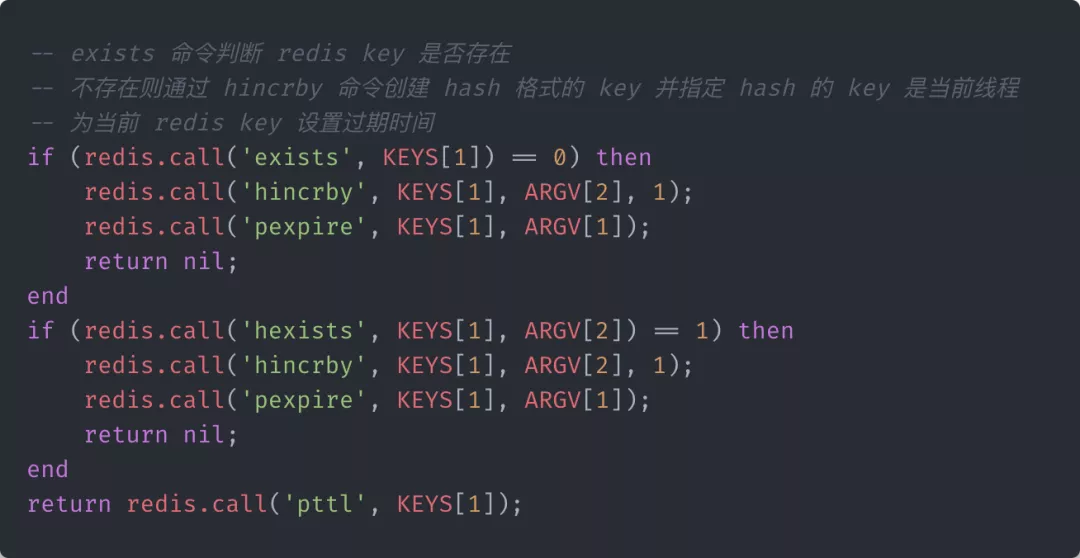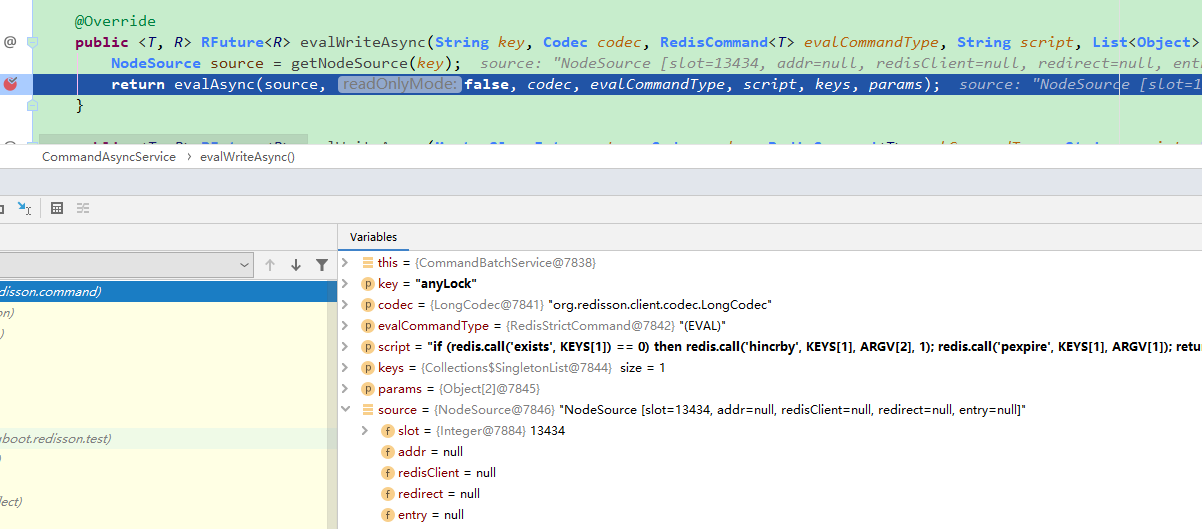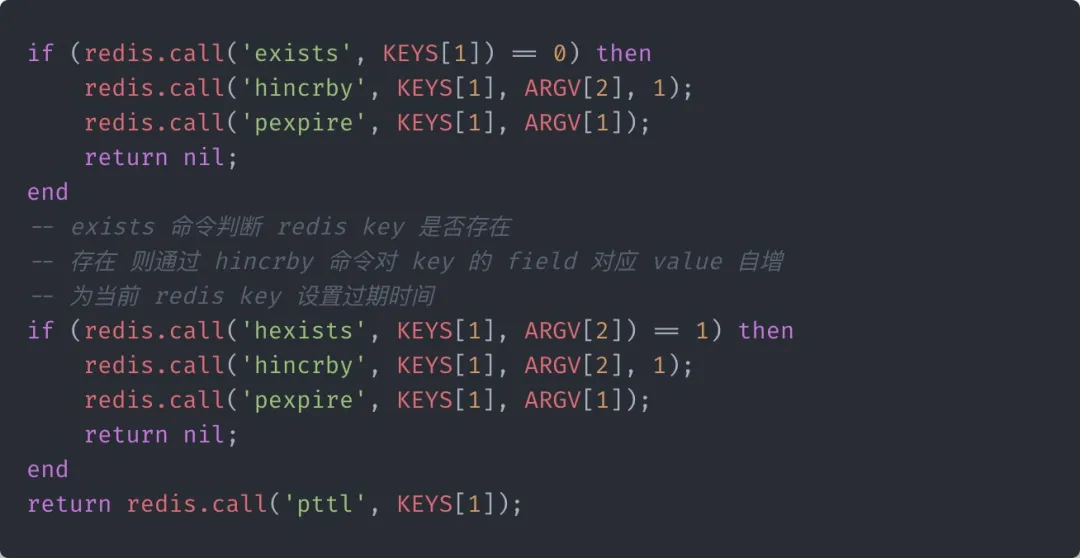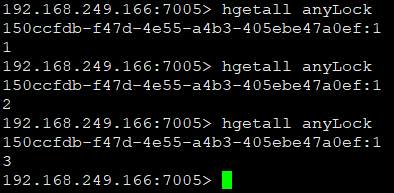在分布式锁—Redisson分布式锁一文中简单介绍了Redisson分布式锁,从这节开始分析一下这块的源码,Redisson版本是3.15.6。
首先看一下可重入锁的加锁流程。
加锁入口
Redisson分布式锁加锁的源码主要都是在RedissonLock这个类中,RedissonLock的加锁方法有很多种,有tryLock、lock,也有同步的、异步的,但都会调用到一个tryLockInnerAsync方法,这是本文要分析的一个重点。但首先我们还是从最简单的lock()方法开始分析。1
2
3
4
5
6
7
8
9
10
11
12
13
14
15
16
17
18
19
20
21
22
23
24
25
26
27
28
29
30
31
32
33
34
35
36
37
38
39
40
41
42
43
44
45
46
47
48
49
50
51
52
53
54
55
56
57
58
59
public void lock() {
try {
lock(-1, null, false);
} catch (InterruptedException e) {
throw new IllegalStateException();
}
}
/**
* 几个不同的lock方法最终都调用到这个私有的lock方法
*/
private void lock(long leaseTime, TimeUnit unit, boolean interruptibly) throws InterruptedException {
long threadId = Thread.currentThread().getId();
Long ttl = tryAcquire(-1, leaseTime, unit, threadId);
// lock acquired
if (ttl == null) {
return;
}
RFuture<RedissonLockEntry> future = subscribe(threadId);
if (interruptibly) {
commandExecutor.syncSubscriptionInterrupted(future);
} else {
commandExecutor.syncSubscription(future);
}
try {
while (true) {
ttl = tryAcquire(-1, leaseTime, unit, threadId);
// lock acquired
if (ttl == null) {
break;
}
// waiting for message
if (ttl >= 0) {
try {
future.getNow().getLatch().tryAcquire(ttl, TimeUnit.MILLISECONDS);
} catch (InterruptedException e) {
if (interruptibly) {
throw e;
}
future.getNow().getLatch().tryAcquire(ttl, TimeUnit.MILLISECONDS);
}
} else {
if (interruptibly) {
future.getNow().getLatch().acquire();
} else {
future.getNow().getLatch().acquireUninterruptibly();
}
}
}
} finally {
unsubscribe(future, threadId);
}
// get(lockAsync(leaseTime, unit));
}
从源码可以看到,lock()方法本身什么参数也没有。但是在这个方法里,调用私有的lock(long leaseTime, TimeUnit unit, boolean interruptibly)方法时会设置 leaseTime = -1。这个 leaseTime 的含义是加锁的时间,-1 表示永久时间,时间的单位由另一个参数unit决定。
接下来看一下lock(long leaseTime, TimeUnit unit, boolean interruptibly)这个方法,在这个方法中,会先调用tryAcquire(leaseTime, unit, threadId)方法,并且传如的threadId参数为当前线程的id,线程id是一个long型正整数。
异步加锁
接下来看一下tryAcquire(leaseTime, unit, threadId)这个方法。这个方法中会掉到tryAcquireOnceAsync这个尝试异步加锁一次的方法。
1 |
|
前面已经说了 leaseTime 是 -1,所以tryAcquireOnceAsync方法中几个参数已经清楚:
- waitTime:-1;
- internalLockLeaseTime:使用默认时间 30000 毫秒;
- TimeUnit.MILLISECONDS:单位毫秒;
- threadId:线程 id;
- RedisCommands.EVAL_NULL_BOOLEAN:eval 命令。
加锁逻辑
加锁逻辑在tryLockInnerAsync这个方法里。
1 | <T> RFuture<T> tryLockInnerAsync(long waitTime, long leaseTime, TimeUnit unit, long threadId, RedisStrictCommand<T> command) { |
可以看到,真正的加锁,其实就是执行这么一段 lua 脚本。使用 lua 脚本是为了保证整个执行过程的原子性。
先说明一下 lua 脚本的参数信息:
- KEYS[1]:getRawName(),加锁的 key ,也即是加锁时设置在redis的 hash 表中的 key,比如 anyLock;
- ARGV[1]:unit.toMillis(leaseTime),锁的毫秒时间,比如 30000;
- ARGV[2]:getLockName(threadId),锁的名称。是 UUID 和线程 id 拼接起来的字符串,比如 931573de-903e-42fd-baa7-428ebb7eda80:1。

首次加锁分析:
- exists 命令判断 redis 中名称为 anyLock 的 key 是否存在;
- 不存在,使用 hincrby 命令,创建 anyLock key 对应的数据;
- 对 anyLock 设置过期时间。
加锁后可以查看redis中的数据(使用了redis的hash数据结构):
可以简单理解为 anyLock 下面挂着一个 K-V 结构的数据:1
2
3"anyLock": {
"83af6711-1001-49f6-9a27-e5c44a5bb93f:1":"1"
}
执行脚本
上面已经确定了 lua 脚本的语句和参数,下一步就行执行了,需要注意的地方就是有个哈希槽路由。1
2
3
4
5
6
7
8
9
10
11
12
13
14
15
16
17
18
19protected <T> RFuture<T> evalWriteAsync(String key, Codec codec, RedisCommand<T> evalCommandType, String script, List<Object> keys, Object... params) {
CommandBatchService executorService = createCommandBatchService();
RFuture<T> result = executorService.evalWriteAsync(key, codec, evalCommandType, script, keys, params);
if (commandExecutor instanceof CommandBatchService) {
return result;
}
RPromise<T> r = new RedissonPromise<>();
RFuture<BatchResult<?>> future = executorService.executeAsync();
future.onComplete((res, ex) -> {
if (ex != null) {
r.tryFailure(ex);
return;
}
r.trySuccess(result.getNow());
});
return r;
}
CommandBatchService类中的evalWriteAsync方法和evalAsync方法,这两个方法都是在CommandBatchService的父类CommandAsyncService类中。
CommandAsyncService中的两个方法:
1 |
|
evalWriteAsync方法中会先获取一个 NodeSource。通过debug可以看到 NodeSource 的值。
接下来会调用evalAsync方法,然后调用到async这个方法。
async方法在CommandBatchService类中是有重写的。1
2
3
4
5
6
7
8
9
10
11
12
13
14
15
16
public <V, R> void async(boolean readOnlyMode, NodeSource nodeSource,
Codec codec, RedisCommand<V> command, Object[] params, RPromise<R> mainPromise, boolean ignoreRedirect) {
if (isRedisBasedQueue()) {
boolean isReadOnly = options.getExecutionMode() == ExecutionMode.REDIS_READ_ATOMIC;
RedisExecutor<V, R> executor = new RedisQueuedBatchExecutor<>(isReadOnly, nodeSource, codec, command, params, mainPromise,
false, connectionManager, objectBuilder, commands, connections, options, index, executed, latch, referenceType);
executor.execute();
} else {
RedisExecutor<V, R> executor = new RedisBatchExecutor<>(readOnlyMode, nodeSource, codec, command, params, mainPromise,
false, connectionManager, objectBuilder, commands, options, index, executed, referenceType);
executor.execute();
}
}
再这个方法中,下一步会进入的else代码块,创建一个RedisBatchExecutor实例,并执行RedisBatchExecutor的execute()方法,其中前面的那个 NodeSource 对象作为构造器的参数传入。
接下来看一下RedisBatchExecutor重写的execute()方法,这个方法很简单,只是调用了其父类中的addBatchCommandData方法。1
2
3
4
public void execute() {
addBatchCommandData(params);
}
最后来看一下addBatchCommandData方法。1
2
3
4
5
6
7
8
9
10
11
12
13
14
15
16
17
18
19
20
21
22
23
24
25
26
27
28
29
30
31protected final MasterSlaveEntry getEntry(NodeSource source) {
if (source.getSlot() != null) {
MasterSlaveEntry entry = connectionManager.getEntry(source.getSlot());
if (entry == null) {
throw connectionManager.createNodeNotFoundException(source);
}
return entry;
}
return source.getEntry();
}
protected final void addBatchCommandData(Object[] batchParams) {
//通过source获取MasterSlaveEntry
MasterSlaveEntry msEntry = getEntry(source);
Entry entry = commands.get(msEntry);
if (entry == null) {
entry = new Entry();
Entry oldEntry = commands.putIfAbsent(msEntry, entry);
if (oldEntry != null) {
entry = oldEntry;
}
}
if (!readOnlyMode) {
entry.setReadOnlyMode(false);
}
Codec codecToUse = getCodec(codec);
BatchCommandData<V, R> commandData = new BatchCommandData<V, R>(mainPromise, codecToUse, command, batchParams, index.incrementAndGet());
entry.getCommands().add(commandData);
}
在addBatchCommandData方法中,会从 source 里面获取到 solt,然后获得 MasterSlaveEntry。MasterSlaveEntry 可以理解为单个redis节点的连接配置对象。
可重入
既然是可重入锁,这块是支持可重入的,接下来看下可重入是如何做的。

重入的流程是:
- exists 命令判断 redis 中 key 对应的哈希数据结构中 field 键是否存在;
- 存在 则通过 hincrby 命令对 key 的 field 对应 value 自增;
- 为当前 redis key 设置过期时间。
比如我调用3次lock方法,查看 redis 中的数据如下:
加锁互斥
上面已经验证了两种情况:
- redis key 不存在;
- redis key 和 key 的 field 存在。
剩下的情况就是 key 存在但 field 不存在。
因为 key 的 field 放的 value 是 UUID:ThreadId,说明加锁的不是当前线程。Redisson对这种情况的做法是直接返回当前锁的剩余时间。
总结
本文主要介绍了 Redisson 可重入锁的加锁、锁重入、锁互斥逻辑。
核心重点在 lua 脚本。同时需要理解 Redis 的 Hash 数据结构。
同时需要记住,在未指定加锁时间时,默认使用的是 30s。
最后,一张图介绍本文加锁逻辑。
